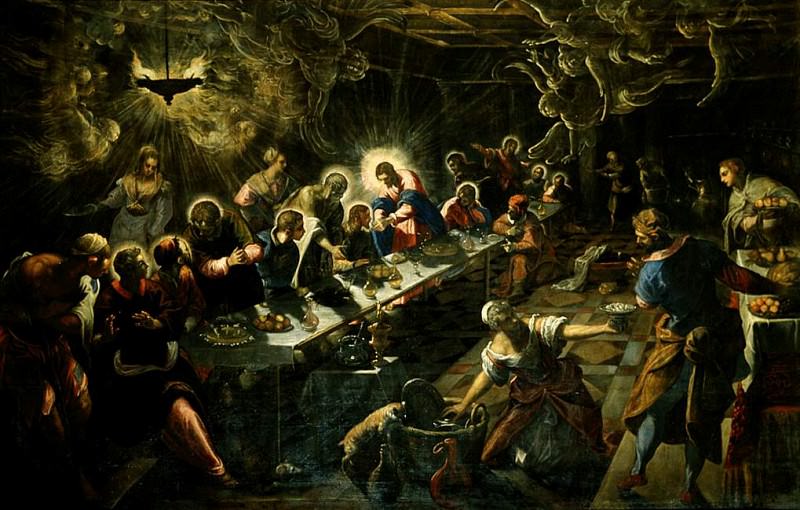Tintoretto Lultima cena, 1592-94, 360x560 cm, San Giorgio M Tintoretto (Jacopo Robusti) (1518-1594)
Tintoretto – Tintoretto Lultima cena, 1592-94, 360x560 cm, San Giorgio M
Edit attribution
Download full size: 1019×649 px (0,1 Mb)
Painter: Tintoretto (Jacopo Robusti)
Tintoretto is a native of Venice, a representative of the late Renaissance school, which is very conventional, however - his work is characterized by a certain style he has developed over the years. For him it is characterized by masterful work with light, fine details, fine elaboration of the faces. Tintoretto was exceptionally talented and worked very quickly, especially when he was working on commission, which sometimes made his pictures sloppy.
Description of Jacopo Tintoretto’s The Last Supper
Tintoretto is a native of Venice, a representative of the late Renaissance school, which is very conventional, however - his work is characterized by a certain style he has developed over the years. For him it is characterized by masterful work with light, fine details, fine elaboration of the faces.
Tintoretto was exceptionally talented and worked very quickly, especially when he was working on commission, which sometimes made his pictures sloppy. This was by no means the case with The Last Supper, however.
The painting depicts the moment in which Christ breaks bread, saying "This is my body. In the cozy company of disciples one senses surprise, but not fear-they are used to the strange words of the teacher, they are not frightened by what he says, they just don’t really understand him.
They glance over, wary of taking the bread that has been so said. And all around them the usual poor tavern continues quietly with life. The maids deliver the food, two visitors argue at the door, the owner says something to the cook, and everyone goes about his business. They are not interested in what is going on right under their noses. They don’t see the angelic light, they don’t see the thin, glowing halos above the heads of the people sitting at the table.
To them it is just an ordinary group of friends who have come to celebrate Easter. A cat climbs into a basket of fish, unaware that the man breaking bread is a god born female. A dog chews on a bone, unaware that he will one day be resurrected. The half-dark tavern, seemingly limitless because of the gloom, holds a real miracle, but no one notices it. And the angels hover over the table unnoticed, and the light of the lamp under the ceiling seems to all to be mere light, not heavenly radiance.
Judas, sitting alone at the edge of the table, is not illuminated by this glow, and is thus separated from the rest. He is already a traitor and is already thinking about his thirty pieces of silver.
"The Last Supper" shows that subtle moment when a miracle happens, remaining unnoticed until the moment.
Кому понравилось
Пожалуйста, подождите
На эту операцию может потребоваться несколько секунд.
Информация появится в новом окне,
если открытие новых окон не запрещено в настройках вашего браузера.
You need to login
Для работы с коллекциями – пожалуйста, войдите в аккаунт (open in new window).

![Tintoretto (Jacopo Robusti) - Якопо Тинторетто - Христос моет ноги своим ученикам [Christ washing the Feet of the Disciples]](http://cdn.gallerix.asia/j/T/691884944/1180130002.webp)
















You cannot comment Why?
Perhaps it’s a painting of a group of people sitting at a long table with food in front of them and a person standing at the end of the table.